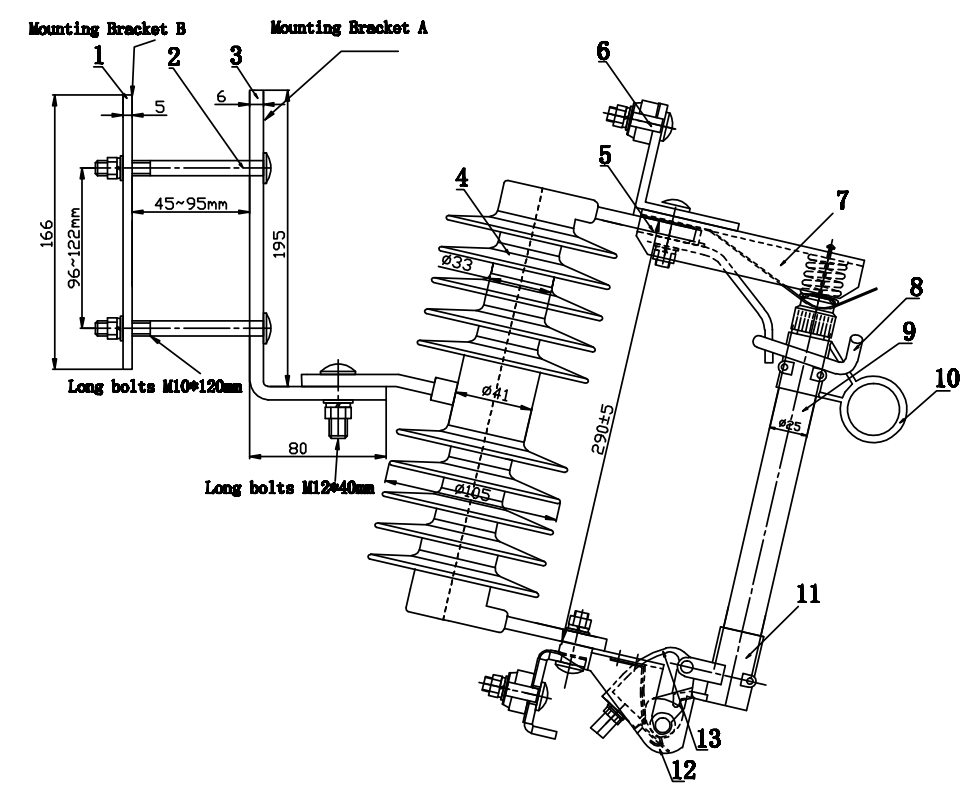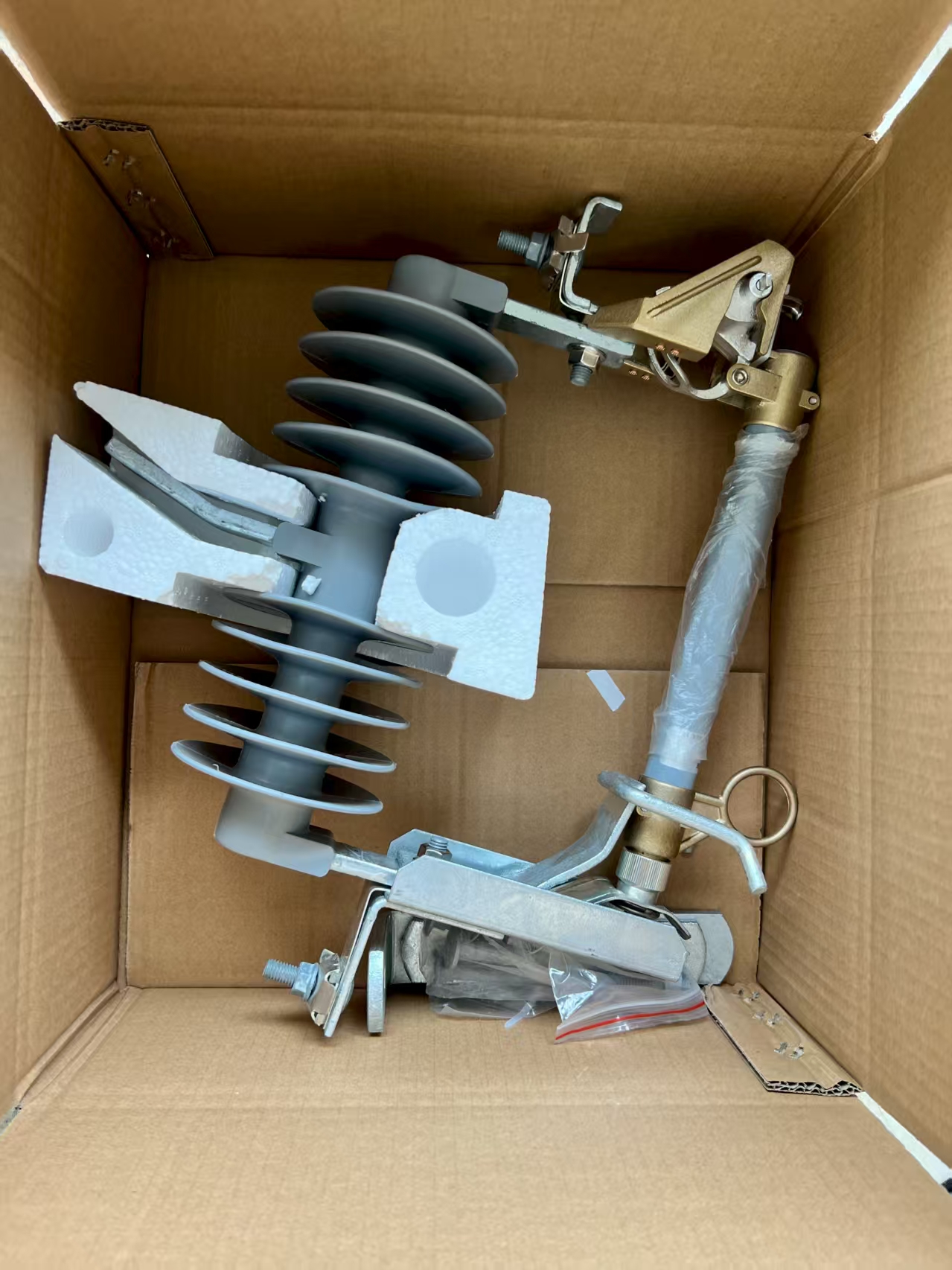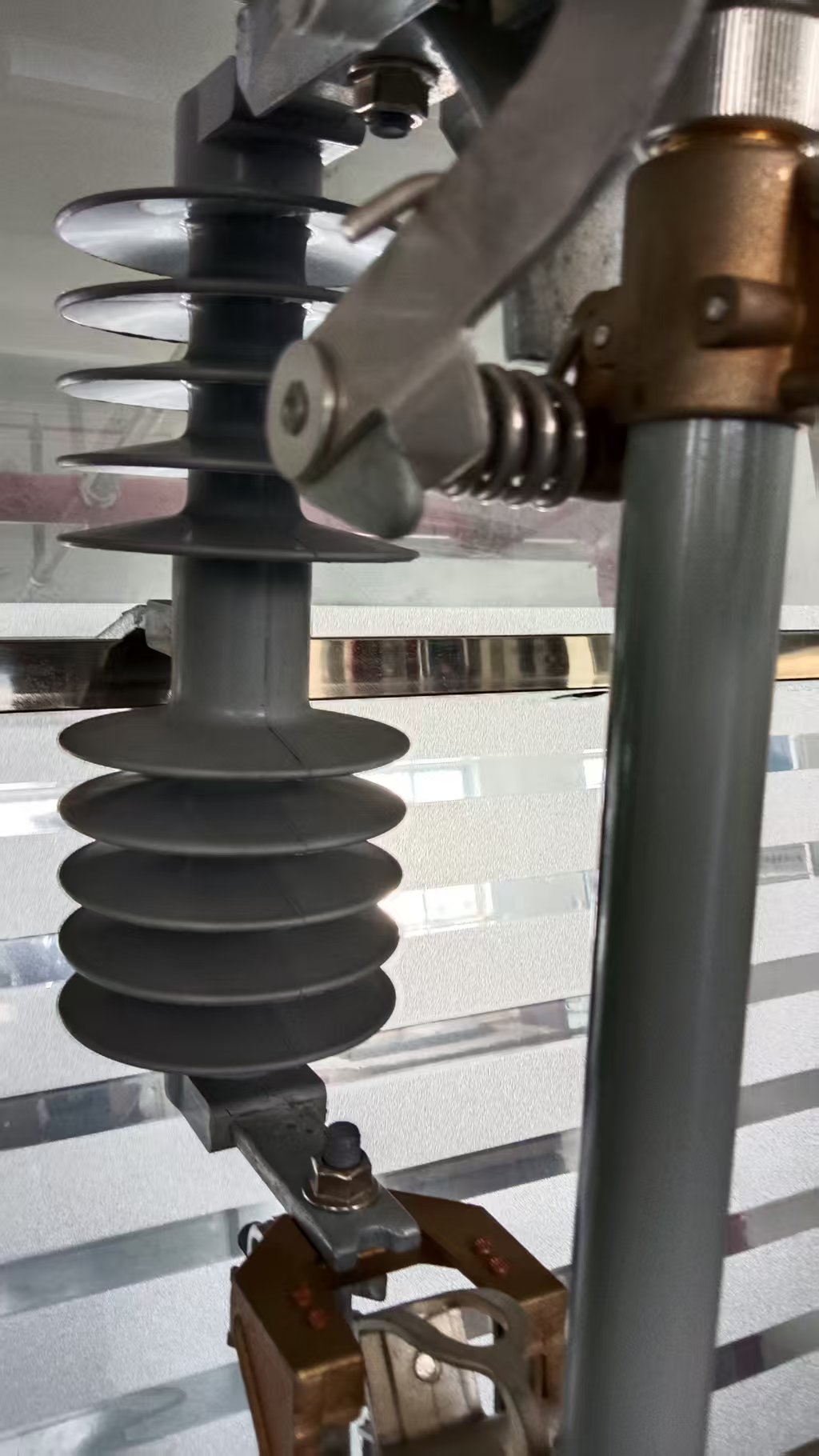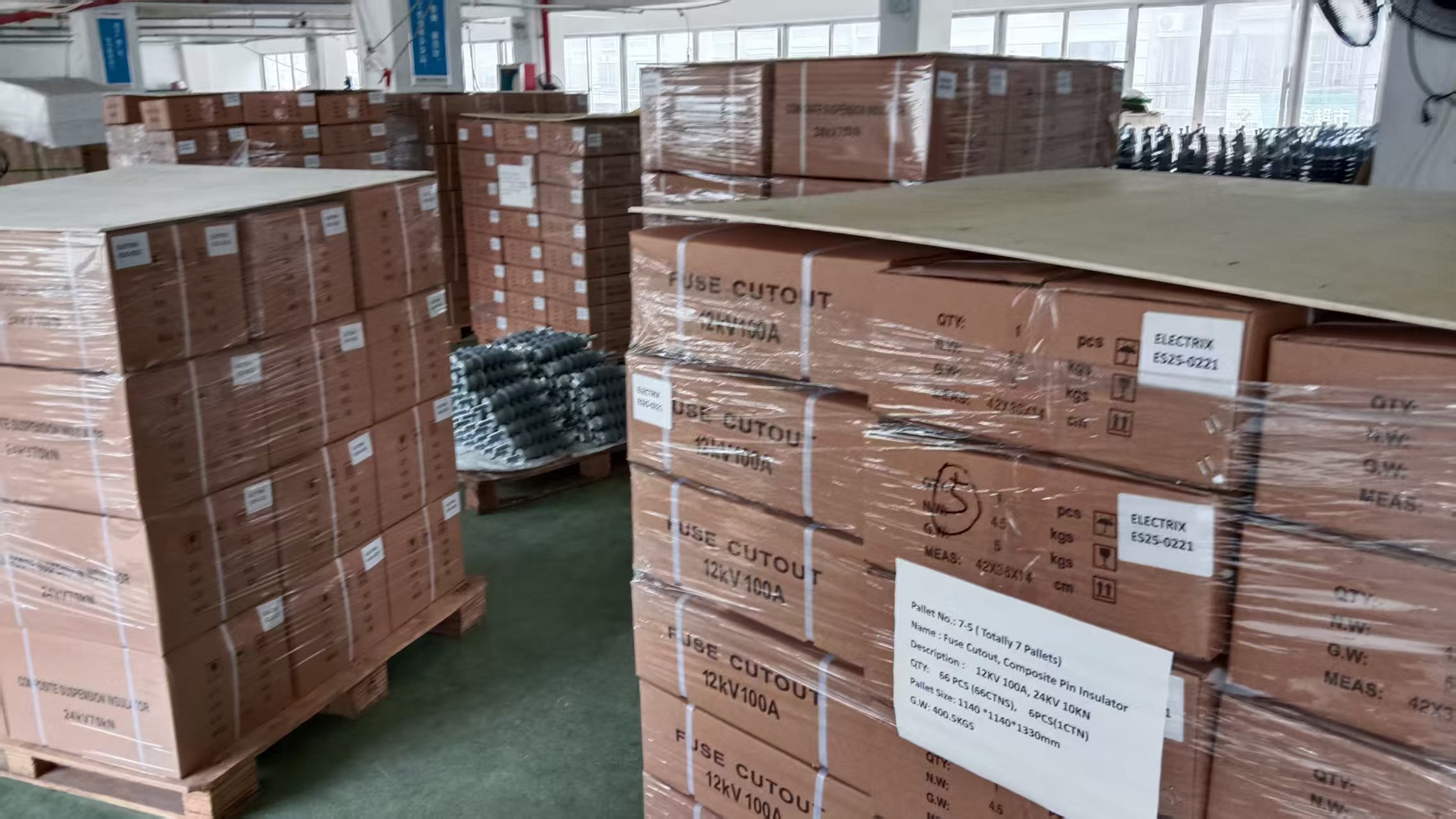| Availability: | |
|---|---|
| Quantity: | |
Product Description:
This 11kV, 100A Drop-Out Fuse Cutout utilizes a silicone rubber insulator with a significantly extended 525mm creepage distance to deliver robust and reliable overcurrent protection for medium-voltage distribution systems. The silicone rubber provides outstanding resistance to environmental stresses, particularly pollution and moisture, while the long creepage path offers a major safety margin against insulation failure under the most severe contamination conditions. Its visible drop-out action ensures safe isolation for maintenance crews. This design is ideally suited for protecting transformers and feeders in demanding operational environments where high insulation integrity is paramount.


Technology Parameter:
Product Description: Silicone Drop Out Fuse ( is also named Polymer Drop Out Fuse, Polymer Fuse Cutout)
Product Type: HRW12-11-100A-525mm
Body - silicone
Rated voltage: 11kv
Rated current: 100A
Breaking current: 10kA
Impulse voltage (BIL): 110kV
Power frequency withstand voltage: 45kV
Leakage distance: 525mm
Weight: 6 kgs
Dimensions: 480x480x145mm
Core Function & Principle:
Overcurrent Protection:Its primary function is to automatically interrupt electrical circuits experiencing excessive current (overloads or short circuits). This protects downstream transformers, lines, cables, and other equipment from damage.
"Drop-Out" Mechanism:When the internal fuse element melts due to overcurrent, the upper fuse carrier assembly is released. It pivots downwards under gravity, visibly "dropping out" of its insulated support. This provides a clear, visible open-circuit indication for line crews, enhancing safety during fault location and maintenance.
Arc Extinction:The fuse tube is designed to contain and safely extinguish the arc generated when the fuse element melts, preventing restrikes and damage to surrounding equipment.

Key Specifications:
System Voltage:11kV (Rated for phase-to-phase voltage in 3-phase systems or phase-to-ground in applicable configurations).
Rated Current: 100 Amperes (Continuous current-carrying capacity under normal operating conditions).
Breaking Capacity:While not explicitly stated here, DO fuses in this class are typically designed to interrupt significant fault currents (e.g., 10kA or 12.5kA is common). The specific interrupting rating must be confirmed from the manufacturer's datasheet.
Creepage Distance: 525mm.This is a crucial insulation parameter.
Definition:The shortest path along the surface of the insulating material between two conductive parts (typically the live terminal/hook and the grounded mounting bracket/base).
Significance:A creepage distance of 525mm is substantial for an 11kV system. Standard requirements (e.g., IEC 60282-1) typically specify minimum creepage based on pollution severity. 525mm far exceeds the minimum requirement for even “Severe Pollution Level (Class IV)” environments (which usually require ~31mm/kV * 11kV = ~341mm). This large margin provides exceptional resistance to tracking and flashover under polluted, humid, or coastal (salt fog) conditions.
Insulator Material: Silicone Rubber (SIR)
Material: The insulator body (the housing supporting the fuse base and the upper contacts/hook) is fabricated from “High-Temperature Vulcanizing (HTV) Silicone Rubber”.

Key Advantages:
Superior Hydrophobicity:Silicone rubber naturally repels water. Its surface recovers hydrophobicity quickly after being wetted, preventing the formation of continuous water films that can lead to leakage currents and flashover. This is vital for performance in rain, fog, and high humidity.
Excellent Pollution Performance: Hydrophobicity and the long creepage path (525mm) work synergistically to minimize the risk of surface tracking and pollution-induced flashover, even under heavy contamination (dust, industrial fallout, salt).
UV & Ozone Resistance:Highly resistant to degradation from sunlight (UV radiation) and ozone, essential for long-term outdoor reliability.
Wide Temperature Range:Performs well across a broad temperature range (-50°C to +150°C+), suitable for diverse climates.
Lightweight:Significantly lighter than traditional materials like porcelain or glass-reinforced polymer (GRP), reducing load on poles and structures, and easing installation.
Impact & Vandalism Resistance: Generally more resistant to shattering from impacts (like flying stones) compared to porcelain. While not indestructible, it often fails less catastrophically.
Good Flame Resistance: Self-extinguishing properties.
Comparison: Replaces older porcelain or GRP (Glass Reinforced Polyester) insulators, offering superior pollution performance, lighter weight, and better impact resistance.
Typical Applications:
Pole-Mounted Distribution Transformers:The most common application, protecting 11kV/400V transformers supplying residential, commercial, or light industrial loads.
Feeder Protection:Protecting branches or sections of 11kV overhead distribution lines.
Capacitor Bank Protection: Isolating capacitor banks on MV networks.
Circuit Sectionalizing:Isolating faulted sections of a distribution feeder.
Areas Requiring High Pollution Performance: Coastal regions, industrial areas, deserts, and regions with high dust or salt contamination levels benefit immensely from the combination of silicone rubber and the extended 525mm creepage distance.

Key Terminology Used:
Drop-Out Fuse (Cutout):The device itself.
Fuse Carrier / Fuse Link Assembly:The removable tube containing the fuse element.
Insulator / Housing:The silicone rubber body providing support and insulation.
Creepage Distance:Surface leakage path length (525mm).
Hydrophobicity:Water-repellent property.
Flashover:Unwanted electrical discharge over the insulator surface.
Tracking:Permanent degradation of the insulator surface caused by leakage currents.
Pollution Severity:Classification of environmental contamination levels (e.g., Light, Medium, Heavy, Very Heavy/Severe).
Breaking Capacity / Interrupting Rating: Maximum fault current the fuse can safely interrupt.
Pole-Mounted:Installed on utility poles.

Company Strength:
 |  |
 |  |
 |  |  |
 |  |  |
Product Description:
This 11kV, 100A Drop-Out Fuse Cutout utilizes a silicone rubber insulator with a significantly extended 525mm creepage distance to deliver robust and reliable overcurrent protection for medium-voltage distribution systems. The silicone rubber provides outstanding resistance to environmental stresses, particularly pollution and moisture, while the long creepage path offers a major safety margin against insulation failure under the most severe contamination conditions. Its visible drop-out action ensures safe isolation for maintenance crews. This design is ideally suited for protecting transformers and feeders in demanding operational environments where high insulation integrity is paramount.


Technology Parameter:
Product Description: Silicone Drop Out Fuse ( is also named Polymer Drop Out Fuse, Polymer Fuse Cutout)
Product Type: HRW12-11-100A-525mm
Body - silicone
Rated voltage: 11kv
Rated current: 100A
Breaking current: 10kA
Impulse voltage (BIL): 110kV
Power frequency withstand voltage: 45kV
Leakage distance: 525mm
Weight: 6 kgs
Dimensions: 480x480x145mm
Core Function & Principle:
Overcurrent Protection:Its primary function is to automatically interrupt electrical circuits experiencing excessive current (overloads or short circuits). This protects downstream transformers, lines, cables, and other equipment from damage.
"Drop-Out" Mechanism:When the internal fuse element melts due to overcurrent, the upper fuse carrier assembly is released. It pivots downwards under gravity, visibly "dropping out" of its insulated support. This provides a clear, visible open-circuit indication for line crews, enhancing safety during fault location and maintenance.
Arc Extinction:The fuse tube is designed to contain and safely extinguish the arc generated when the fuse element melts, preventing restrikes and damage to surrounding equipment.

Key Specifications:
System Voltage:11kV (Rated for phase-to-phase voltage in 3-phase systems or phase-to-ground in applicable configurations).
Rated Current: 100 Amperes (Continuous current-carrying capacity under normal operating conditions).
Breaking Capacity:While not explicitly stated here, DO fuses in this class are typically designed to interrupt significant fault currents (e.g., 10kA or 12.5kA is common). The specific interrupting rating must be confirmed from the manufacturer's datasheet.
Creepage Distance: 525mm.This is a crucial insulation parameter.
Definition:The shortest path along the surface of the insulating material between two conductive parts (typically the live terminal/hook and the grounded mounting bracket/base).
Significance:A creepage distance of 525mm is substantial for an 11kV system. Standard requirements (e.g., IEC 60282-1) typically specify minimum creepage based on pollution severity. 525mm far exceeds the minimum requirement for even “Severe Pollution Level (Class IV)” environments (which usually require ~31mm/kV * 11kV = ~341mm). This large margin provides exceptional resistance to tracking and flashover under polluted, humid, or coastal (salt fog) conditions.
Insulator Material: Silicone Rubber (SIR)
Material: The insulator body (the housing supporting the fuse base and the upper contacts/hook) is fabricated from “High-Temperature Vulcanizing (HTV) Silicone Rubber”.

Key Advantages:
Superior Hydrophobicity:Silicone rubber naturally repels water. Its surface recovers hydrophobicity quickly after being wetted, preventing the formation of continuous water films that can lead to leakage currents and flashover. This is vital for performance in rain, fog, and high humidity.
Excellent Pollution Performance: Hydrophobicity and the long creepage path (525mm) work synergistically to minimize the risk of surface tracking and pollution-induced flashover, even under heavy contamination (dust, industrial fallout, salt).
UV & Ozone Resistance:Highly resistant to degradation from sunlight (UV radiation) and ozone, essential for long-term outdoor reliability.
Wide Temperature Range:Performs well across a broad temperature range (-50°C to +150°C+), suitable for diverse climates.
Lightweight:Significantly lighter than traditional materials like porcelain or glass-reinforced polymer (GRP), reducing load on poles and structures, and easing installation.
Impact & Vandalism Resistance: Generally more resistant to shattering from impacts (like flying stones) compared to porcelain. While not indestructible, it often fails less catastrophically.
Good Flame Resistance: Self-extinguishing properties.
Comparison: Replaces older porcelain or GRP (Glass Reinforced Polyester) insulators, offering superior pollution performance, lighter weight, and better impact resistance.
Typical Applications:
Pole-Mounted Distribution Transformers:The most common application, protecting 11kV/400V transformers supplying residential, commercial, or light industrial loads.
Feeder Protection:Protecting branches or sections of 11kV overhead distribution lines.
Capacitor Bank Protection: Isolating capacitor banks on MV networks.
Circuit Sectionalizing:Isolating faulted sections of a distribution feeder.
Areas Requiring High Pollution Performance: Coastal regions, industrial areas, deserts, and regions with high dust or salt contamination levels benefit immensely from the combination of silicone rubber and the extended 525mm creepage distance.

Key Terminology Used:
Drop-Out Fuse (Cutout):The device itself.
Fuse Carrier / Fuse Link Assembly:The removable tube containing the fuse element.
Insulator / Housing:The silicone rubber body providing support and insulation.
Creepage Distance:Surface leakage path length (525mm).
Hydrophobicity:Water-repellent property.
Flashover:Unwanted electrical discharge over the insulator surface.
Tracking:Permanent degradation of the insulator surface caused by leakage currents.
Pollution Severity:Classification of environmental contamination levels (e.g., Light, Medium, Heavy, Very Heavy/Severe).
Breaking Capacity / Interrupting Rating: Maximum fault current the fuse can safely interrupt.
Pole-Mounted:Installed on utility poles.

Company Strength:
 |  |
 |  |
 |  |  |
 |  |  |